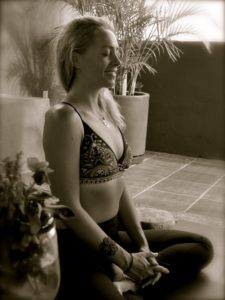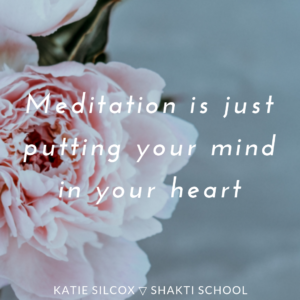It’s Cervical Cancer Awareness Week.
Cervical cancer, although treatable, is the 3rd leading cause of death of women worldwide. Ayurveda has a lot to offer in terms of prevention and treatment of cervical cancer. I want to start with the emotional and energetics first…
The womb area is our feminine heart. It is the seat of our creative capacity, as well as where our ability to heal and rejuvenate our own body. The feminine womb is also a storehouse for much of our past pain, whether it is sexual trauma, abandonment, or other forms of abuse. Ironically, it is the center of pleasure and watery, creative power. Think of your womb as an oceanic force—dark and healing.
I have found that this area tends to be quite numb in many women and that they have a hard time connecting with this part of themselves, particularly if they have experience trauma like surgery on or removal of reproductive organs, or abuse. Abuse depletes self-worth, our personal power. This especially effects the womb.
One of the most enlightening and surprising realizations I came to with Ayurveda is how the seat of female sexual power lies in the womb—the dark, fleshy home of our creative energies. What I learned is that in this sacred female heart, we create. Our creation makes babies, it births social activism projects, it produces art, it bakes bread, and it starts businesses. I also learned that the womb is the seat of our destructive powers. In this sacred female heart, we bleed, we feel pain, and we slough off a layer of who we are each month.
To expand into our fullness and heal energetic balances, we must first create an open, wide base in which energy can move. Many of the women I work with have a lack of prana moving in their pelvic bowl. How alive do you feel at your roots? If you close your eyes, what does it feel like “down there”? Assess the situation with love, and then practice this meditation for increasing prana in your sacred pelvic bowl.
Tune In
Close your eyes and sit comfortably with the spine straight, or lay down. Feel your whole body begin to relax. Take a few moments to watch your breath, let it become even, smooth and full. As you feel your body beginning to relax, take your awareness down into your pelvic root and bowl. Without judgment, look around down there with your inner felt-sense. Are there spots that feel alive, vibrating and full of light? Are there spots that are tense, scary, dark or numb?
Take a few moments to breathe your presence into the realms that feel stuck, numb or emotionally/physically painful. Feel that you can access energy from outside of the body as you inhale, and on the exhale, direct it into the stuckness, allowing it to dissolve. Do this for 5-10 minutes. As you begin to notice energetic shifts, there may be emotional releases that accompany this meditation. Try your best not to judge the release, but to let it unravel.
Come back to your practice, and back to your breath. After 10 minutes, begin to visualize a dark, downward-facing dark blue triangle, its apex pointing downward towards earth at your tailbone, and the base as wide as your hips. When you feel your body breathing in, sense your awareness, and energy, move through the dark blue triangle and down to the tip, concentrating there. As you feel your body exhale, sense any holding, tension, toxins or unwanted emotion leaving through the tip, and moving down into the earth. Repeat this visualization and movement of energy 8-12 times.
The mantra SOM (pronounced sohm) is an excellent healing tonic for this area.
The female womb is the seat of our deepest emotional mystery, pulling us down and out each month, asking us to deeply feel the truth of what we didn’t process the month prior, nourishing us throughout our lives with hormones. This center is the home of our unconscious lust, and in it dwells our secret desires, hopes, and loves. It’s why at various times of the month our sensitivity can be more intense—when we might feel our most vulnerable both physically and emotionally. If this center is blocked or numb, undernourished and unloved, you may feel disconnected from your creativity, sexuality and power. Through these practices, you will nourish this center, making it a viable home for your spirit to work and live.
Our menstrual cycle can be a time in which we can let go of any toxic emotions or holding patterns that we accumulated the month before. If we do not allow ourselves the necessary time and space for this to be felt as a visceral, emotional and spiritual experience, we dishonor the very power that we are, perhaps, longing for all month long. Not only can we slow down during our menstrual cycle, but we should also take exquisite care of ourselves. Practice inwardness and slowing down during the last week and first few days of your cycle, to honor the feminine energy working through you and cultivate intentional nourishing energy.
Ayurveda’s personal approach to nutrition, as well as following a healthy daily routine, and emotional wellbeing, are the first line of defense when it comes to dealing with all diseases, including cancer…
Recent researches have proved that many of the spices used in Ayurvedic cooking have anti-cancerous effects. Curcumin, the compound that gives Turmeric its yellow color, is a powerful antioxidant, which neutralizes free radicals that increase the risk of cancer and is said to inhibit the growth of cancerous cells. Ginger is particularly significant for cancers which show high levels of inflammation, a characteristic of cervical cancer. Holy Basil/Tulsi, an herb rich in Ursolic Acid is regularly included in a cancer fighting diet.
Another tool for prevention and relief is vaginal douching, steaming, and suppositories, prepared with herbs according to each woman’s personal needs. Suppositories are easy to make at home with a little coconut oil. You can find powerful yet simple recipes for making your own online. Goldenseal and coconut oil is a great one.
If you are on the pill, reconsider. I know that this is not a popular option, especially for modern career-minded women, but here is the thing—menstrual blood helps cleanse the organs and kill off any foreign invaders (and by the way, men’s sperm is rife with bacterial friends). With every period, you literally clean out any foreign bodies in your holy womb. This is probably why many of us actually feel “cleansed” from life’s experience after a good menstrual cycle. If you are taking a pill that alters or even eliminates this natural cycle, you may be missing out on one of the best immune-boosting, life-giving processes in your life.
There are many other reasons why we may want to reconsider taking synthetic hormones. New and emerging scientific evidence actually shows a clear link between taking hormonal contraceptives and depression and an increased risk of cancer. In 2005, the World Health Organization’s cancer research group listed hormonal contraceptives as “carcinogenic to humans.” Do the research, be informed, and know that there are time-tested natural ways to prevent unwanted pregnancy. What’s more, is that natural contraceptive methods will help you further tune into your body and womb.
And finally, keep your immune system strong. Certain strands of HPV can cause cancer. If your immune system is strong, you should be able to clear this virus within a couple of years. If you have a family history of cervical cancer, you should get a PAP smear every year. Otherwise, make sure you’re having one done every three years.






 Our culture supports individual effort and perfection. In fact, I recently read about an experiment done on two groups of people, one from the United States, and another group from Japan. Each group was shown an image that included an individual scuba diver sinking into an ocean full of fish and other marine life. The group was given a few minutes to look over the image, and was later asked to recall what was presented there.
Our culture supports individual effort and perfection. In fact, I recently read about an experiment done on two groups of people, one from the United States, and another group from Japan. Each group was shown an image that included an individual scuba diver sinking into an ocean full of fish and other marine life. The group was given a few minutes to look over the image, and was later asked to recall what was presented there.



